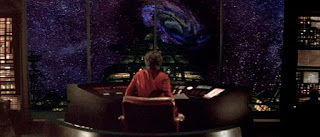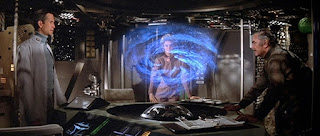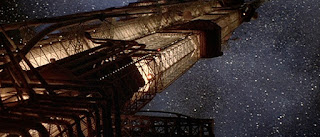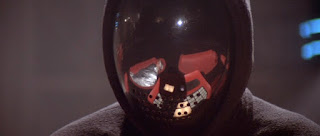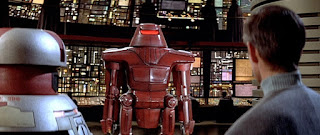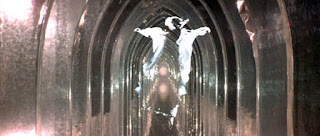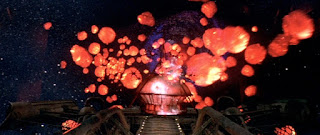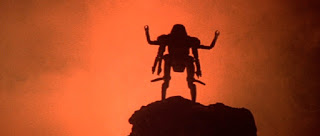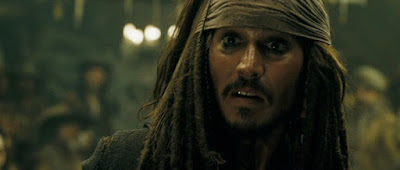No one sets out to make an
iconic character, or at least those that do usually don’t accomplish this. These
characters are just connect with an audience and grow into a phenomenon. If you
are an anime fan, you know who Totoro is, you can’t escape his fuzzy presence.
If you don’t know who Totoro is, then go watch My Neighbor Totoro as soon as you can, because he is an iconic
character, not just in Japan, but around the world.
Summary:
Satsuki (Noriko Hidaka) and
Mei (Chika Sakamoto) are moving to the country with their father (Shigesato
Itoi). We soon discover that the girl’s mother (Sumi Shimamoto) is sick and
hopefully the country air will help her get well. But mother has to stay in a
local hospital until she is well enough to join the three at the new place.
After they arrive the girls think mysterious Dust Bunnies may haunt the new
home. Satsuiki and Mei explore the house and discover clues to supernatural inhabitants.
In the meantime the girls help
their dad around the house and make new friends like Kanata (Toshiyuki Amagas)
a young boy who thinks Satsuki is cute, but doesn’t know what to do about it.
They also befriend kindly old Granny (Tanie Kitbayashi) who tells them about
the forest spirits that live nearby. That is when Mei encounters the Totoro, a
huge furry creature living in a huge camphor tree near the house. Totoro and
his tiny friends befriend the girls and take them on all kinds of adventures
including flying through the air, taking a ride on a Cat Bus and entering an enchanted
tree. But when mother takes a turn for the worse is there anything Totoro can
do to help the girls in there hour of need?
Good Points:
- Miyazaki creates a wonderful sense of place and wonder in the animation
- Totoro and all the supernatural creations are a joy to behold
- You grow to like all the characters in the film
Bad Points:
- There isn’t really an overall story, more like a series of vignettes
- Looking for an antagonist to boo? Not going to find one here.
- Some may find the movie too simple or too childish (I don’t agree, but I’ve heard that argument before)
Overall:
This is a wonderful example
of family entertainment. Young children will connect with the protagonists and
fall in love with Totoro and his pals. Adults will find a nostalgic quality to
the film that is so appealing. The movie puts you into the world of a child and
does it so effectively. All the pieces come together to make a film that is
entertaining and soothing all at once. It isn’t hard to see why this became a
big hit and remains a classic in Miyazaki’s filmography ever since.
Scores
(out of 5)
Visuals: 5
Sound: 4
Acting: 4
Script: 4
Music: 4
Direction: 5
Entertainment: 5
Total: 4
In Depth Review
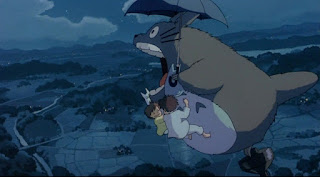 |
| The big Totoro lets out a giant Yawp! |
I often hear Hayao Miyazaki
called the Japanese Walt Disney, and I think his work on My Neighbor Totoro and Kiki’s
Delivery Service is where that idea comes from. I appreciate the
comparison, but it doesn’t quite fit. Both men are more then just comparison
points to each other. As I mentioned above, you could compare Totoro to Mickey
Mouse when it comes to a popular icon created from family entertainment. Totoro
is inescapable in Japan. And if you have any stores near you that sell
merchandise or pop culture from Japan (especially anime or manga) odd are you’ve
seen Totoro there too.
Why the lasting appeal? Why
the accolades? Why the huge amount of success that allowed Miyazaki to continue
with his dream of making animated films into 2013? Let’s take a look at all the
different elements and see how they work together.
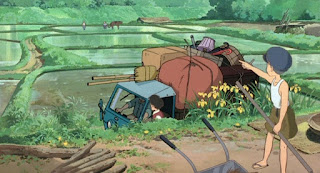 |
| The pastoral and old fashioned setting. |
The country setting allows
Miyazaki to show off nature in the form of the giant camphor tree, the rolling
hills surrounding the village and waving open fields of grass. My Neighbor Totoro feels much more open
and airy compared to Castle in the Sky.
The setting adds to the nostalgic atmosphere that wraps the whole film in a
comfy familiar blanket, even for non-Japanese audiences.
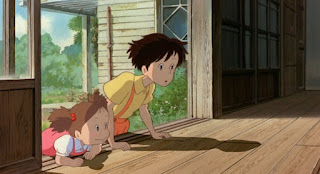 |
| What mysteries await in the new house? |
Like the previous films,
some of the visual highlights include moments when characters take flight.
Totoro uses a magic top to take to the air with Mei and Satsuki. Later in the
movie, the flying Cat Bus hurtles across the countryside and leaps high into
the air, providing a thrilling ride for those inside. It just wouldn’t be a
Miyazaki film without those moments.
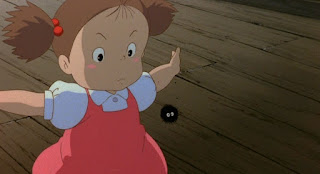 |
| Who ya gonna call? Dust Bunny Busters! |
Sound work follows suit for
the film. Most of what we hear is typical sound effects for the pastoral
setting and vintage cars. When some magic is needed for the Totoros and the Cat
Bus then some interesting sound design is used. It is all creative and
immersive.
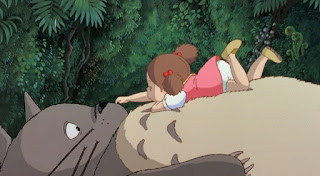 |
| Mei befriends the giant Totoro. |
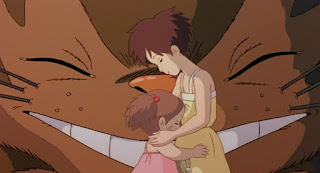 |
| Even the Cat Bus is pleased that Mei and Satsuki find each other. |
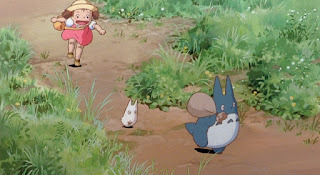 |
| Mei in hot pursuit of the white rabbit... I mean little and medium Totoros! |
 |
| Satsuki is isolated in this frame, as she searches for the lost Mei. |
It takes a deft touch to
make something like My Neighbor Totoro work.
For me this is the first film where everything comes together just about
perfectly for Miyazaki. His abilty to capture that childlike wonder, that
thrill of discovery, the fear of the unknown and the dispair of losing someone
so important to you – all these elements come into play in this simple story.
But it is that simplicity that makes the film so endearing, entertaining and
have that staying power. Pretty much anyone who sees My Neighbor Totoro will not forget it. Children connect with the
girls and the cute and helpful Totoro. Adults will pick up on the nostalgia for
a simpler time and the delightful visuals that capture the imagination. Miyazaki
even manages to include a little ecological message about the Totoros being
spirits of the forest and being attracted growing plants.
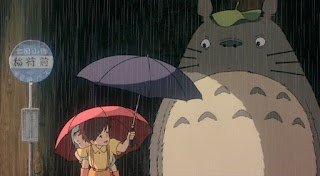 |
| The leaf hat just isn't cutting it. |
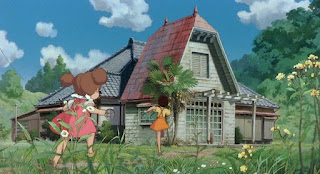 |
| The girls rush to find adventure in the "haunted house". |
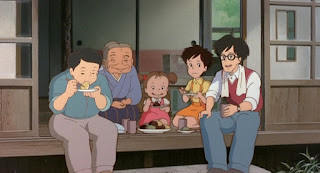 |
| Time for a snack after the move. |
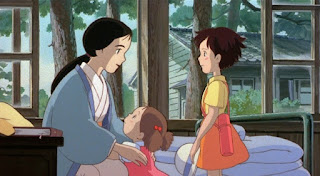 |
| The girls visit their sick mother. |
 |
| She seeks him here, she seeks him there. She seeks that rascal everywhere. |
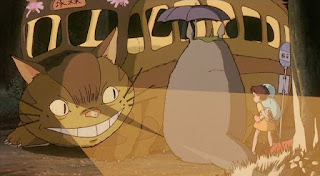 |
| And then this happened... a cat bus appeared. |
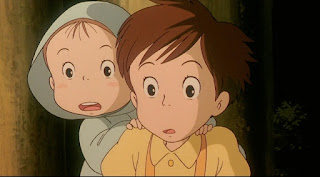 |
| "Are you seeing this $%@&?" "Yeah, I totally see a Cat Bus." |
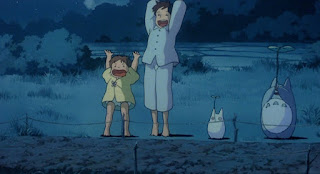 |
| The girls and the Totoro's combine forces to make the little acorns grow. |
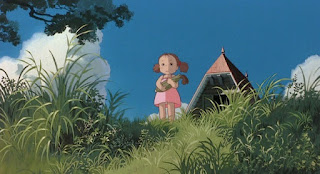 |
| Mei is a child of the corn. |
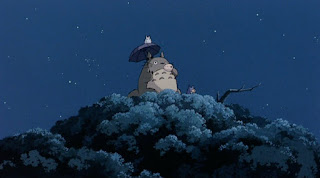 |
| Hey Link, I think the Totoro has the Ocarina of Time. |
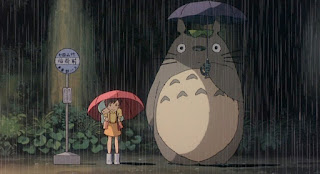 |
| This has to be one of my favorite scenes in the movie. |




